The Kievan Rus’ – When Vikings and Slavs Cooperated to Shape History
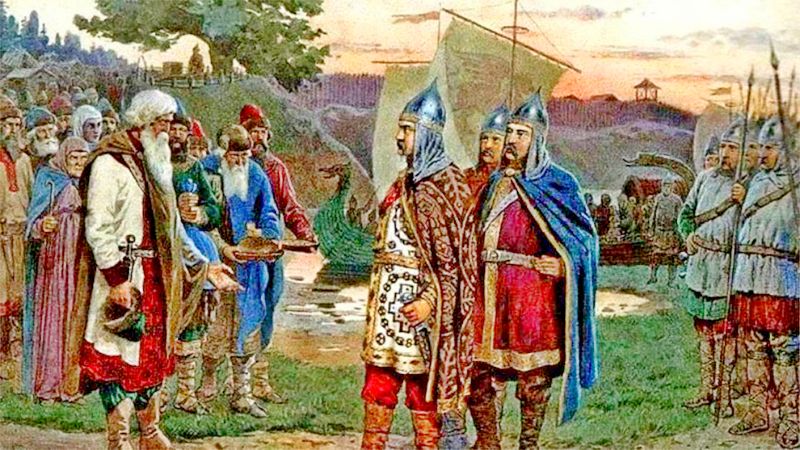
UPDATED 1 JULY, 2020 - 22:56 ALEKSA VUČKOVIĆ
The history of the Slavs is a long and ancient tale. Their roots reach far into the past, deep into the oldest beginnings of Europe. These culturally, linguistically, and genetically connected peoples inhabited great swaths of Europe, and they inhabited these lands for many centuries. In time, distinct groups of Slavic peoples emerged: the Polabians in the far North, the Western Slavs, the Southern Slavs, and the Eastern Slavs. And it was these Slavic tribes who became the peoples of Kievan Rus’ territory.
This article about these ancient Eastern lands examines the emergence and the history of the so-called Kievan Rus, a medieval federation of East Slavic tribes with a unique and rich history. The modern states of Russia, Ukraine, and Belarus all have their formative roots in the history of the Kievan Rus’. But who were the rulers of this federation? And who was its greatest leaders?
The Earliest Origins of the Kievan Rus’
From the earliest times, the shores of the Baltic Sea were inhabited by Slavic tribes. But the old Balts, ancient cousins of the Slavs, only thrived in the northwestern area of the Baltic Sea. From those lands, all the way south to the Black Sea, the East Slavic tribes thrived for many decades, always settling in the easternmost reaches of Slavic tribal expansion.
In the very north, around the city of Novgorod, the tribe of Ilmen Slavs or Slovenes, who were linguistically connected to the Polabian Slavs to the West, thrived. Neighboring them was the important Kryvichi, a powerful Slavic tribal union. Other Slovene neighbors included the Drevlyans, the Volhynians, the Polans, the Radimichs, the Dregovichs, and the Vyatichs. To the north of the Slovenes were the Finnic tribes, mainly Chuds and Veps. And to the East were the Volga Finnic tribes, the Mordvins, Merya, Mari, and the Muromians.
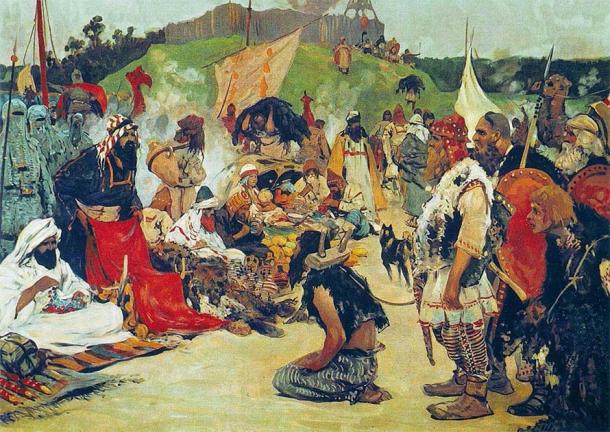
Kievan Rus' trade negotiations with the Eastern Slavs.
The multitude of tribes, different languages, and cultures made for an interesting setting. However, relations between these tribes were largely peaceful, with only minor conflicts.
The Slavic and Finnic tribes of the region were for the most part simple, peaceful agrarians. They were worshippers of a well-developed natural polytheistic pantheon, without a strong central authority. These tribes were for the most part familial clans, similar to the Scottish Highland clans or the old Serbian tribes of Montenegro.
The East Slavic and Finnic tribes were relatively easy to exploit by their larger and more powerful neighbors. Around the 9 th century AD, the territories of these peoples were continuously influenced by the Khazars to the southeast and the Varangians to the northwest. These Varangians (Old Norse Væringjar) were Vikings, Norsemen mostly from Sweden, who sailed eastwards through the river systems of the lands they called Garðaríki (The Realm of Towns). These river systems were protected by Slavic river forts. At some point, the Varangians began settling in these lands, and soon after they imposed a tribute “tax” on the Slavic tribes.
According to the writings of the Primary Chronicle, the Slavs fought the Varangians in 862 and drove them out of their lands. But soon after, as they had no centralized leadership, they lapsed once more into inter-tribal conflicts, much to their disadvantage. It is said that these tribes decided to let the Varangians govern them according to certain laws, in order to have a centralized rule for a greater cause.
Relying on ancient writings such as the Primary Chronicle for the definitive historical facts can be questioned. We can’t know for sure whether the Norse rulers were “invited” to rule over the Slavic tribes, or if they imposed their rule through force and power. Nonetheless, it is known that three prominent Varangian chiefs settled in the most prominent Slavic towns as rulers. These were Sineus, Truvor, and Rurik, and they ruled Izborsk, Beloozero, and Novgorod, respectively. Soon after, only Rurik remained alive, and thus he became the sole ruler of the entire realm, and the progenitor of a powerful ruling dynasty known as the Rurikids, which ruled over Russia until 1610.
How the Norsemen of the North Became the Kievan Rus’
But who were these Rus’ people over whose lands did the Rurikids begin to rule? To this day, the ethnicity of the Rus’ people is debated. The name Rus’, still an extant Slavic word, could easily come from the Proto-Slavic word *rusъ, which means “fair-haired, blonde.” But whether these were Norse immigrants into Slavic lands, or Slavs themselves, cannot be stated with certainty. Either way, the small Norse population that came to rule over the Slavs quickly became assimilated into Slavic society and culture, and their Norse names were Slavicized.
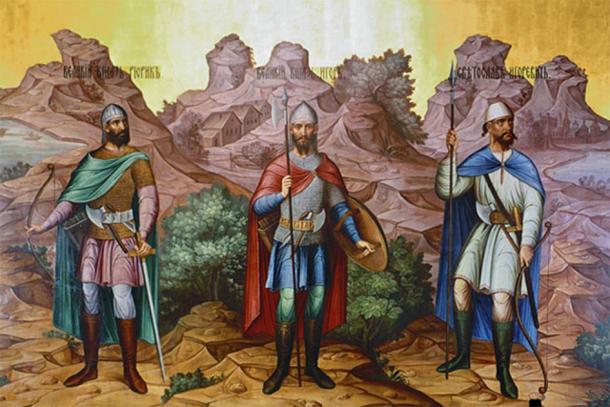
The first Rurikids during the rise of the Kievan Rus’ (Братья Белоусовы /
After Rurik died in 879 AD his kinsman, Prince Oleg (Old Norse Helgi) became regent, since Rurik’s son Igor (Old Norse Ingvar) was still too young to rule. A year after becoming regent, Oleg of Novgorod sailed his forces up the Dnieper River to Kyiv, capturing several towns on the way. He killed the two Norse chieftains in Kyiv, Askold and Dir, captured the city, and made it the capital of all Rus’ lands thereby creating the foundation of the Kievan Rus’.
From Kyiv, Oleg of Novgorod led further campaigns along many river systems into the lands of the Slavs. He conquered the Slavs, imposed his rule, taxed them, and consolidated his power. The area of the Kievan Rus’ was a highly lucrative location, and the Norse peoples clearly understood this fact when entering Rus’ lands. Major trade routes passed through the lands of the Slavs, and the region was rich in natural resources, slaves, and furs. These economic factors gave the Kievan Rus’ the wealth and power for further greatness.
From his new capital of Kyiv, Oleg soon launched an ambitious raid on the heart of the Byzantine Empire: Constantinople. In 907 AD, with the Slavic warriors at his back, he successfully attacked Constantinople and affixed his shield to its gates. The attack concluded with a trade agreement that greatly benefited the Kievan Rus’.
Oleg’s successor was Igor. He continued the expansion of the Kievan Rus’, and besieged Constantinople twice, in 941 and 944 AD. In 945 AD, he concluded a favorable peace treaty with the Byzantines. In that same year, Prince Igor was killed by the Slavs while exacting tribute from them. The Slavs bent two tall, young birch trees, tied the Prince between them, and let them spring back into position, thus tearing him into pieces. He was eventually succeeded by his son, the legendary Sviatoslav I of Kyiv.
The Ideal Kievan Rus’ Warrior – Sviatoslav of Kiev
In the history of the Kievan Rus’, Sviatoslav was the first Rurikid ruler to rule over a dynasty with a Slavic name (Sviato Slav – holy Slav ), indicating the speed of their assimilation into Slavic society. Of course, it is possible that Sviatoslav was named to further appease the Slavic tribes and make the Rurikid rulers more acceptable.
Sviatoslav reigned from Kyiv from 945 to his death in 972 AD and is one of the most famous rulers of the Kievan Rus’. His rule was marked by continuous and successful military campaigns in the east and to the south, campaigns that led directly to the collapse of two very powerful entities: the First Bulgarian Empire and Khazaria.
Sviatoslav’s rule clearly demonstrates the true nature of the Rurikid rule. He further divided the Slavs, and from Kyiv, he led conquests to successfully subdue the semi-independent East Slavic tribes. And he continued to defeat the Alans and the Volga Bulgars. At the same time, he frequently formed alliances with the Pechenegs and Magyars, traditional enemies of Slavs.
However, Sviatoslav I was probably the first Rurikid ruler to be thoroughly Slavicized, only his Norse heritage argued otherwise. His appearance is well documented. He wore the traditional Slavic side hair lock, had a large mustache, and swore by the Slavic gods Perun and Veles.
Sviatoslav’s highly successful and influential reign ended abruptly in 972 AD when he was assassinated. To hamper his success and further the enmity between the Pechenegs and the Kievan Rus’, the Byzantines bribed the Pecheneg Khan to assassinate Sviatoslav. This occurred at the Khortitsa cataracts. The Pecheneg Khan made his skull into a drinking cup.
After Sviatoslav’s death, the history of the Kievan Rus’ entered a crucial period. He had three sons, two, Oleg and Yaropolk, by an unknown wife, and one, Vladimir, by a bondswoman, a Slavic servant woman named Malusha. After Sviatoslav’s death tensions between the three sons grew as they all vied for the throne of the Kievan Rus’.
These tensions culminated in a full-fledged war between Yaropolk and Oleg in 976 AD. Oleg was killed in this conflict leaving only Yaropolk and Vladimir. Upon hearing of his brother’s death, Vladimir fled to Scandinavia to his cousin Haakon Sigurdsson, to avoid being killed. There he assembled a force of Viking mercenaries and returned to his lands in 980 AD. He then murdered Yaropolk through treachery and became the sole ruler of the Kievan Rus’.
The Height of Kievan Rus’ Power Under Yaroslav I
Once he became the ruler, Vladimir brought Kievan Rus’ to its greatest heights of power and influence. He became Vladimir the Great, Grand Prince, and continued the steady expansion of his lands. And, due to the political influences of the time, Vladimir renounced the pagan Slavic faith and proceeded to formally Christianize Kievan Rus’.
As was expected, when Vladimir died, his sons immediately began feuding for the right to rule. His son, Sviatopolk I killed three of his own brothers but was eventually defeated by his remaining brother, Yaroslav.
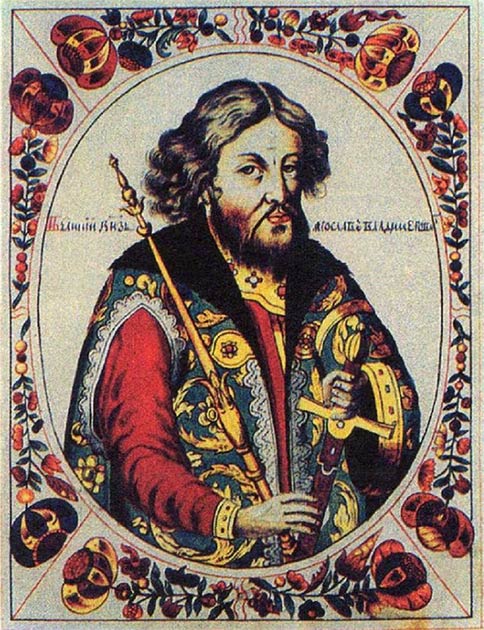
Yaroslav the Wise leads the Kievan Rus' to their greatest glory
Yaroslav I or Yaroslav The Wise ruled over Kievan Rus’ for a long period, and during that time Kievan Rus’ reached its absolute peak in military, cultural, and political power. He successfully consolidated his rule, protected all his borders, and successfully campaigned against the Byzantines. Furthermore, he began the important codification of legal customs, which evolved into a code of law, the first of its kind in Kievan Rus’ history.
Unfortunately, after the death of Yaroslav I, the power of the Kievan Rus’ gradually declined. Regional clans and rulers gained more power, which greatly fragmented the state. Furthermore, successions became increasingly difficult, with brothers constantly feuding and murdering each other in order to attain power. From these feuds emerged a pronounced fragmentation and conflict between major cities. These conflicts produced the Republic of Novgorod, and the Principality of Polotsk, who both feuded for power. In the north, Slavs began forming a territory that would become the foundation of the later Grand Duchy of Moscow, another fragmentation of Kievan Rus’ lands. These regional feuds also created another principality, Vladimir-Suzdal.
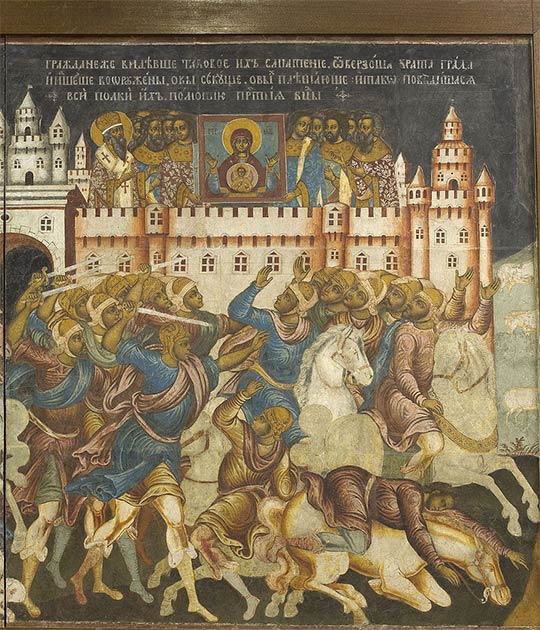
A battle between the Republic of Novgorod and Vladimir-Suzdal after the fall of Kievan Rus’
All of these feuds and fragmentations created a highly unstable political situation in the region and effectively left the once all-powerful Kievan Rus’ in a state of decline. When the Mongols invaded Kievan Rus’ lands in the 13 th century AD, this dissolution of what was once Kievan Rus’ was finally complete. The Kievan Rus’ lands would not be united again until 1547 AD, with the emergence of the Russian Empire under Ivan IV the Terrible.
- The Precious Knowledge of the Hypatian Codex: Detailed Chronicle of the Southern Rus
- Ulpiana, A Wealthy Ancient City Destroyed by Greed
- Norsemen transformed international culture, manufacturing, tech and trade during Viking Era
Ultimately Greed Defined Kievan Rus’ Success and Failure
The history of the Kievan Rus is certainly interesting. Although the Kievan Rus’ did not rule for centuries, their importance cannot be denied. As is almost always the case with great, powerful, and wealthy nations and dynasties, greed drove a destabilizing wedge between brothers, sons, and fathers, ultimately leading to downfall.
Greed was the defining trait of the Vikings. They saw the potential for power and wealth in the undisturbed lands of the Slavs, and they exploited that potential. And from those Vikings, only one rose to prominence. Rurik and his descendants ruled for centuries and accomplished great deeds that significantly influenced the developments of global history. These deeds led to the emergence of the Russian Empire and many other important developments. If the Kievan Rus’ didn’t rule over the Slavs, how different would our lives be today?
Top image: Calling of the Varangians, part of early Kievan Rus' history Source: Алексей Кившенко /
By Aleksa Vučković
Rurik Dynasty - Rurik the Viking to Ivan the Terrible (video)
Editors Commentary:
*Follow the WEF trail to Switzerland to discover the Khazarian Mafia hiding behind Klaus Schwab and his cohorts. The US and its people have nothing to do with the disasters caused to the ordinary people of the Earth.
The Khazarians have once again constructed an intricate web, whose aim is to destroy the world's economy by setting people up against each other, blocking each other's supply chains, leaving just death and ruins.
What everybody must be aware of is that this is not a war to prevent Putin from occupying Ukraine, but an attempt by the evil Khazarian Jews/WEF/NATO to control yet another country in their growing New World Order. They are simply using Ukraine as a battlefield. Their plan is to destroy totally the world's economy and turn the population into slaves.
Like the Freemasons, they have also life-threatening rules in their membership, one being REVENGE, 10 times harder than was ever perpetrated on them.
Russia in particular, in the past, has expelled the Khazars several times. I have all of 7 detailed articles in book format on the Khazarian Jews if anybody is interested in further information.
Putin, and earlier also Trump, are the ONLY Presidents who have enough guts to see what they are attempting to do to the world population and have sufficient courage to do something about it.
HUMAN SYNTHESIS
COPYRIGHTS
Copy & Paste the link above for Yandex translation to Norwegian.
WHO and WHAT is behind it all? : >
The bottom line is for the people to regain their original, moral principles, which have intentionally been watered out over the past generations by our press, TV, and other media owned by the Illuminati/Bilderberger Group, corrupting our morals by making misbehavior acceptable to our society. Only in this way shall we conquer this oncoming wave of evil.
All articles contained in Human-Synthesis are freely available and collected from the Internet. The interpretation of the contents is left to the readers and does not necessarily represent the views of the Administrator. Disclaimer: The contents of this article are the sole responsibility of the author(s). Human-Synthesis will not be responsible for any inaccurate or incorrect statement in this article. Human-Synthesis grants permission to cross-post original Human-Synthesis articles on community internet sites as long as the text & title are not modified.
HUMAN SYNTHESIS